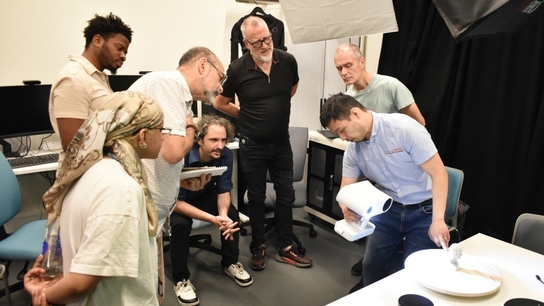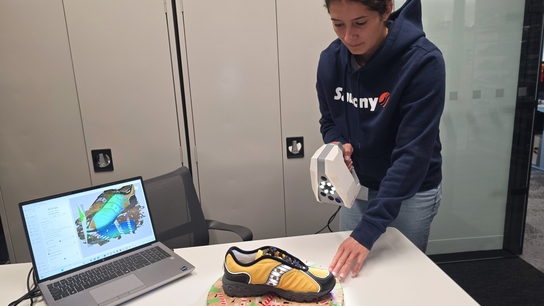Maximizing crop yields with high-throughput phenotyping using Artec Space Spider
Challenge: A researcher focused on high-throughput phenotyping of perennial ryegrass needed a way to non-destructively measure 160 individual plants in the field 6-8 times over the duration of his project, to help identify specific plants with the most desirable traits for plant breeders and farmers.
Solution: Artec Space Spider, Artec Studio, ImageJ, 3D Slicer
Results: Artec Space Spider was used to precisely capture each ryegrass spike in minutes, resulting in submillimeter-accurate 3D scans of each plant, giving researchers in-depth views across the duration of the growing cycle. Post-scanning, the 3D models of the spikes were digitally “skeletonized,” revealing with pinpoint accuracy the topographical essence of each spike’s structure.

A flowering perennial ryegrass spike
Our world is running out of food, and it’s only getting worse. The global population is surging higher and is expected to surpass 9.7 billion by the year 2050. Numerous experts assert that the level of food production needs to rise by 50-98% by then, just to achieve a stable degree of food security. That’s even without factoring in the unpredictable effects of climate change, which are accelerating as we draw nearer to the mid-century mark.
Farmers worldwide are facing the daunting challenge of growing more crops than ever on decreasing areas of land. And despite droughts, floods, pestilence, and plant disease, to somehow achieve sustainable crop yields.
With hundreds of millions worldwide going to bed hungry each night, we’re still a long way off from even meeting today’s food security needs. One thing that experts from East to West agree upon is this: if we’re ever going to untangle this Gordian knot, unparalleled innovation in agriculture will be needed.
The latest tech, with ancient roots
One such cutting-edge innovation for boosting crop yields amidst challenging conditions is the process of high-throughput phenotyping (HTP). In a nutshell, phenotyping is the act of observing and analyzing specific plants, then making determinations and predictions based upon a plant’s individual observable characteristics. This is what farmers have been doing for more than 10,000 years now.

Ancient Egyptian priest with wheat, Temple of Horus, circa 2nd century BCE
As they walked through their fields, they carefully selected the plants with the most desirable traits, from which they would gather seeds for future planting. Seeds were stripped from the crops still standing, while seeds that had already broken off (shattered) from the plants and fallen to the ground were simply ignored. Plants with insect damage and other signs of weakness were also given the cold shoulder.
Repeating this process thousands of times down through the generations has resulted in, for the most part, resilient, nutritious crops that today feed billions around the world. At present, approximately 75% of human calories come from just 12 major crops, so by first focusing on these plants, we have the greatest chance of meeting humanity’s rising food needs.
By combining “high-throughput” with phenotyping, that’s where things get really interesting. Essentially this means using various non-destructive tools and technologies to rapidly heighten the accuracy of plant data collection and analysis. The traditional method of phenotyping called for chopping a plant off and carrying it back to the lab for analysis. Once there, the plant’s complex physical characteristics were assiduously studied and measured with an arsenal of rulers and calipers.
The urgent quest to solve an industry-wide problem
The laborious method of measuring by hand is the industry standard and has been for decades, but with the rise of technology, high-throughput phenotyping has sprung to life. One researcher who recognized HTP’s massive potential for a faster and far more accurate way of non-destructively collecting data from plants is U.S. Space Force Major Travis Tubbs. During his research on perennial ryegrass at Oregon State University, Tubbs understood that he needed a way to precisely analyze hundreds of plants in a fraction of the time that the older method entailed.

Diagram of perennial ryegrass (Lolium perenne)
Perennial ryegrass is the most popular and best-adapted cool-season grass crop, used in many countries for feeding livestock. Just in the state of Oregon alone, 360 million pounds of ryegrass seed were harvested in 2019, with sales of the seed valued at more than $186,000,000. And yet 20% or more of the ryegrass grown there every year is irretrievably lost due to early seed shattering, when the seeds break off from the plant prematurely.
Shattering is a common feature among many plants, and when it happens at the right time, it results in seeds being dispersed and eventually turning into the next generation of plants.

Perennial ryegrass at Oregon State University’s Hyslop Crop Science Field Research Laboratory
According to Tubbs, “In order to accurately understand which ryegrass family lines are less prone to premature seed shattering, you need to analyze the spikelets of hundreds of plants, to measure how tightly they hold their seeds, as well as their height and length. If you try to do this via the old method of manual measurement, not only will you have a bunch of dead plants on your hands, but you’ll never be able to precisely measure that many spikelets in the brief window of time you have during each growing cycle.”
3D scanning enters the picture
After exploring the capabilities of photogrammetry and similar methods of rapid data capture, Tubbs was on the verge of designing his own 3D scanner for use in the field. That’s when he came to the Artec 3D website and discovered the Artec Space Spider, a professional handheld 3D scanner that’s been a favorite among researchers for years. He quickly contacted his local dealer and arranged for an in-person demonstration.

The Artec Space Spider
Richman Siansimbi of Artec Gold Certified Reseller Digital Scan 3D met with Tubbs, and together they scanned some samples of ryegrass plants using the Space Spider. That afternoon, Tubbs not only saw that the Space Spider’s submillimeter scans would give him more than enough detail for his analyses, but with Siansimbi’s help, they experimented and came up with an effortlessly repeatable workflow for scanning ryegrass plants, which Tubbs still uses to this day.
Tubbs simply walks out into the field and finds the plant with the spikelets he wants to capture. Then he carefully bends the top of the plant down to the ground and brings it to rest against a backdrop used for scanning. Originally this was a purple rubber exercise band, as it was wide and flexible enough to lay flat against the ground and remain there during the scanning process, which took less than a minute for each plant.

Artec Studio 15 screenshot showing a Space Spider scan of a ryegrass spike
After further experimentation and the online help at the Artec website, Tubbs discovered that a rigid black & white board as a backdrop made for easier scan processing in Artec Studio software. For researchers looking for an even more expedient solution, Tubbs recommends simply using a piece of newspaper, which will do just fine, particularly if the ends are weighted down in case of any wind present.
Proving the exceptional accuracy of the technology
To scientifically confirm the accuracy of the Artec Space Spider, Tubbs took an established measurement (ruler) and photographed it with a Nikon D5000 DSLR. He then processed the photograph using ImageJ software, marking each centimeter (cm) of the ruler’s 20 cm length. This process was repeated on the scanned model.

Top: 3D Artec Space Spider scan with each cm measured. Bottom: 2D image from Nikon D5000, measured with ImageJ software

Graph comparing 2D image measurements accuracy vs 3D Artec Space Spider accuracy
Tubbs then graphed both measurements to visually depict the accuracy between the two capture methods. This process indicates that both forms of measurement are accurate at measuring perennial ryegrass spikes with high fidelity. The 2D photograph measurement has an error of ±1.72 mm. While the Space Spider scan has an error of ±0.09 mm. The slight differences in accuracy between the two methods is not statistically significant (P-value of 0.92), yet it does serve to validate the accuracy of the equipment.
3D scanning ryegrass spikes in the dark
Throughout the two years of the project, on his scanning days, Tubbs would drive out before sunrise to Oregon State University’s Hyslop Crop Science Field Research Laboratory and begin scanning. After a few hours, he’d call it quits until evening, when he would start up again. The Artec Space Spider’s unique capture method even allowed Tubbs to work all through the night, when ambient light was at a minimum. All in all, Tubbs had 640 ryegrass plants under his care.

Google Maps image marking the origins of the 40 different ryegrass seeds supplied by the USDA
These plants originated from seeds collected by the USDA from 40 different locations around the world, places as far and wide as Ireland, Denmark, Belgium, the Netherlands, Greece, Algeria, New Zealand, the United States, and elsewhere. From those original 40 seeds, Tubbs raised then selected the four most representative of their genetic “family.” This resulted in a “repetition” of 160 plants. These 160 plants were cloned four times and randomly planted in a large field, to remove environmental variables from the analysis.
Tubbs scanned only one replication or 1/4th of the entire 640-plant total; this smaller replication made it possible for Tubbs to scan and analyze each plant 6-8 times over the duration of the project. These approximately 800 high-resolution 3D scans from Space Spider have given Tubbs an immense wealth of precise and revealing data on which plants are least prone to seed shattering and why.

Artec Studio 15 screenshot showing a Space Spider scan of a ryegrass spike in x-ray mode
Tubbs summarized his scanning process over time, saying, “Prior to each scan, I would mark the spike, then a week later I would come back and capture the same spike again. After I repeated this process three or four times, I could confidently say that this is what each spike and all of its spikelets looked like to begin with, and this is what they look like now. From beginning to end, you can precisely measure the organic growth taking place throughout every single structure of each spike.”
Tubbs continued, “The traditional method of phenotyping doesn’t give you this kind of crystal clear window into the growth cycle of the plant. You have to destroy the plant in order to measure it. And once you do that, you’ll never be able to say how it will grow and what it will look like tomorrow or the next day or next week.”
The Space Spider edge for precision high-throughput phenotyping
With the Space Spider scans, Tubbs can quantify each and every spikelet down to below a millimeter, with precise measurements across all the irregular surfaces and geometries present. This includes complete topographical characteristics of the clumps of seeds on each spikelet, their numerous angles and aspects, as well as the abscission zone (where the seed breaks away from the plant), all of which are crucial when it comes to interpretation of each plant’s unique phenotype.

Perennial ryegrass spikelets
As opposed to the massive volume of rigorously accurate data that he captured with Space Spider, Tubbs reflected on the old way of phenotyping, saying, “They would just take random samples from 30 or 40 individual plants. And then state that those random samples represent the entire big picture, albeit on a smaller scale. If you look at all of the scientific papers where researchers are using that old method, that’s essentially what they’re doing.”
Taking his analyses even more precise, Tubbs exported the 3D scans into 3D Slicer, an open-source software package for image analysis and scientific visualization, where he began “skeletonizing” the high-resolution models of the ryegrass spikes. 3D Slicer lets Tubbs digitally slice up each 3D spike into a stack of thousands of separate, circular slices.

Skeletonized Space Spider scan of a ryegrass spike
Normally used for x-rays, CT and MRI scans, this functionality gives Tubbs the raw material for the next stage of the skeletonizing process. By taking these digitally sliced-up 3D spikes into ImageJ software, Tubbs determines the exact center of each and every slice of the thousands that make up each spike.
He then connects the very center of each slice, line by line, with the subsequent slice, thus resulting in one contiguous, skeletonized spike. In Tubbs’ words, “This condenses the plant down to the very center, the anatomical essence of its structure, with all its complexity, and it gives me as a researcher just what I need for studying such characteristics as spike length and architecture, the number of spikelets per spike, the distance between spikelets along the rachis, as well as the angle of spikelet attachment to the rachis, spikelet size, and other aspects.”
Superior insect-resistant, drought-tolerant grains, fruits, and vegetables
Once the plants with the most desirable traits and outcomes in the field are pinpointed, these specific plants can be studied at the genetic level and used for propagation and breeding with other plants. This way, in a minimum of generations, researchers can bring about not only superior ryegrass, but all kinds of other plants as well, from rice and barley and wheat to a whole spectrum of fruits and vegetables. Plants that will be highly insect-resistant and drought-tolerant, and require little to no pesticides.
But, in Tubbs’ words, “This is a race with no finish line. Because even as we come up with more robust plants, insects are adapting just as fast if not faster to overcome the plant’s resistance. This is a war that’s been waged between plants and pests for millions of years now. We’re trying to tip the scales in the plants’ favor by picking the ones that have traits that will help the plants survive and thrive. High-throughput phenotyping and Artec Space Spider can help us stay ahead of all the other competitors.”

A comparison between the different aspects of high throughput phenotyping using digital collection methods
The search for effective tools for achieving this is only increasing. In Tubbs’ words, “Today in agriculture, huge sums are being spent on research dedicated to effective high-throughput phenotyping solutions. Researchers everywhere are racing to find out how to do this for every single crop in the world. All of agriculture is trying to figure that out right now.”
He continued, “As for me, I’m focusing on ryegrass because that’s the staple crop of where I am. But we could just as easily do the same thing with corn or wheat or any number of other grains and plants.”
Speaking about the scanner’s intuitive ease of use, Tubbs said, “The technique I use for capturing ryegrass or any other plant is not difficult to learn. I’ve taught people how to use the Artec Space Spider at some of the conferences we’ve attended. There are some different techniques that I use when out in the field, and I’m always happy to share these with other researchers.”
Reaffirming his confidence in the technology, Tubbs said, “There is no question that high-throughput phenotyping, what I’m doing with Artec Space Spider is the future of agriculture. It enables plant breeders and farmers to select plants with the most desirable traits fast enough to respond to immediate and future demands, whether that means being resistant to the latest disease or producing a plant that will grow best with the changing environment. The faster we can make selective decisions, the better we can prepare for future needs.”
Scanners behind the story
Try out the world's leading handheld 3D scanners.





